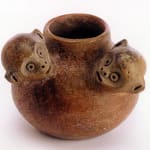Chorrera Terracotta Bowl Decorated with Monkey Heads, 1100 BCE - 300 CE
Terracotta
5.25
PF.2612
The Pre-Columbian cultures of Ecuador are among the oldest in South America and among the first to master the art of pottery. Although we know little about the peoples themselves...
The Pre-Columbian cultures of Ecuador are among the oldest in South America and among the first to master the art of pottery. Although we know little about the peoples themselves or their traditions, historians have been able to piece together a picture of life in Ancient Ecuador thanks in part to the art and artifacts left behind. The culture of Valdivia created some of the oldest known works of art in the Americas. Situated along the coastal strip of Ecuador, the Valdivians established a thriving society that flourished for around two thousand years (from approximately 4000 to 1500 B.C.). Today they are famed for their small fertility figures, believed to be the earliest representational works of art in the Americas, first carved from stone, later formed from terracotta.
Hundreds of years later after the Valdivians disappear from the archaeological record appears another culture to which the name Chorrera has been attached (lasting from circa 1100-300 B.C.). Little is known about this culture; however, it is significant for its widespread geographical reach. As such, their artistic style greatly influenced those diverse cultures that began to emerge in the final centuries of the Chorrera period, a time historians have labeled the Period of Regional Development.
Here we see the results of a skilled Ecuadorian potter whose ceramic techniques involved not only the creation of an elegantly shaped bowl, but the delightful and novel inclusion of a pair of infant monkey heads, projecting in a creative manner from the shoulder of the vessel. While the monkeys' large, circular eyes stare innocently at the world, their open mouths appear as if ready to utter infantile primate sounds, understood only by their unseen mother. The artist's incorporation of an incised linear pattern around the shoulder of the vessel creates an overall sense of balance and harmony to this vessel, further evidencing the unique Ecuadorian ceramic tradition that has continued to awe and inspire mankind down through the ages.
Hundreds of years later after the Valdivians disappear from the archaeological record appears another culture to which the name Chorrera has been attached (lasting from circa 1100-300 B.C.). Little is known about this culture; however, it is significant for its widespread geographical reach. As such, their artistic style greatly influenced those diverse cultures that began to emerge in the final centuries of the Chorrera period, a time historians have labeled the Period of Regional Development.
Here we see the results of a skilled Ecuadorian potter whose ceramic techniques involved not only the creation of an elegantly shaped bowl, but the delightful and novel inclusion of a pair of infant monkey heads, projecting in a creative manner from the shoulder of the vessel. While the monkeys' large, circular eyes stare innocently at the world, their open mouths appear as if ready to utter infantile primate sounds, understood only by their unseen mother. The artist's incorporation of an incised linear pattern around the shoulder of the vessel creates an overall sense of balance and harmony to this vessel, further evidencing the unique Ecuadorian ceramic tradition that has continued to awe and inspire mankind down through the ages.



